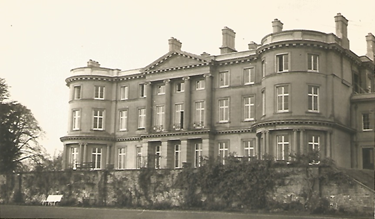Kingsholm Vexillation fortress and the Silures
Kingsholm Vexillation
fortress and the Silures
by Dr Tim Copeland
by Dr Tim Copeland
Although I have been
on ‘missionary duty’ living in Oxfordshire and Gloucestershire carrying out archaeological projects ranging
from the Iron Age in the Thames Valley, Roman villas and deserted medieval villages,
I have remained a member of the Association because I still consider
Monmouthshire to be an important part of my personal heritage, and indeed my
first experience of fieldwork was as a ten year old ‘excavating’ with Jeremy
Knight at Cold Bath Road in Caerleon.
 |
| Tim Copeland with Jeremy Knight at the excavation at Cold Bath Road, Caerleon |
My ‘lock-down’ task has been a continuation of my retirement
project of writing up unpublished excavations, the last one being a 1977
exploration at Chedworth Roman Villa. My subject over present incarceration has
been the preparation for publication of a 1989 excavation in Gloucester, more
specifically at Kingsholm, famous for the stadium of the Cherry and Whites rugby
team. Kingsholm in the northern part of the city is at the lowest crossing
point of the River Severn and is thought to be the location of a vexillation fortress
holding part of a legion, and its associated auxiliary units, on the front line
of the region to be annexed by the Roman army. If this is so then it prompts an
important question: Where were the limits of the Silurian peoples’ territories in
the early Roman period of AD 47-60s when this military site was occupied? At
the present time we consider that the River Wye was the boundary, but Kingsholm
lies a long distance from that line. In the past it has been proposed that the
border might be the River Severn and perhaps the recent LiDAR survey of the
Forest of Dean which discovered fortlets/signal stations of this period, the
dating of which was ascertained by excavation, supports this conception. (Hoyle,
J., (2019) ‘Hidden Landscapes in the Forest of Dean’ Swindon: Historic
England).
While permanent fortresses had civilian settlements outside
the defences, at a short-lived, active, vexillation fortress such as Kingsholm
and its purpose of subduing the Silures, space would be at a premium, and any extra-mural
land would be used strategically in: a construction camp, an annexe for the
production of metal work needed in the fortress or in the field, a wagon park,
an area for the stabling cavalry horses, a provision storage area, a parade
ground, a space for soldiers to congregate for ‘social time’, a zone for the
keeping of livestock, a protected camping site for a unit, a local market for
troops. These uses might change as the campaign progressed and the advance
needed different materials or troop deployments. The original excavator of the
1989 site suggested that it might have been a marketplace with a metalled surface,
however being just 100 metres from the fortress defences it is more likely to have
had a military role. One of the major problems at most legionary fortresses is
identifying the location of cavalry barracks with horses and troopers sharing
the same space as can be seen at auxiliary forts throughout Wales. I am
interpreting the 1989 site as used by the cavalry, as there are indications of
stabling.
My next task will be examining and preparing for publication an
adjacent site that was the subject of a salvage excavation in 1988 ahead of
another housing estate. Hopefully it will throw up further evidence of the use
of the landscape outside the fortress.
Tim Copeland
Editor's Note
The excavation was undertaken at Sandhurst Road in 1989 by Gloucester Archaeology.
See also W. H. Manning, The Roman; 'Conquest and the Army', in The Gwent County History Vol. 1 Gwent in Prehistory and Early History. 178-180. Professor Manning states that in the early stages of the conquest Legions were subdivided between large forts called vexillation fortresses and brigaded with auxlliary units to form small battle groups. He records that Kingsholm controlled an important Severn river crossing and probably was complemented with at least one other vexillation fortress. There are three known in the Wye Valley, two at Clifford and one at Clyro. See also Tacitus, Annals 12, 38.
The excavation was undertaken at Sandhurst Road in 1989 by Gloucester Archaeology.
See also W. H. Manning, The Roman; 'Conquest and the Army', in The Gwent County History Vol. 1 Gwent in Prehistory and Early History. 178-180. Professor Manning states that in the early stages of the conquest Legions were subdivided between large forts called vexillation fortresses and brigaded with auxlliary units to form small battle groups. He records that Kingsholm controlled an important Severn river crossing and probably was complemented with at least one other vexillation fortress. There are three known in the Wye Valley, two at Clifford and one at Clyro. See also Tacitus, Annals 12, 38.
For more information about Dr Tim Copeland see https://uniofglos.blog/history/dr-tim-copeland/
His latest book is 'Life in a Legionary Fortress', Amberley, 2014.



